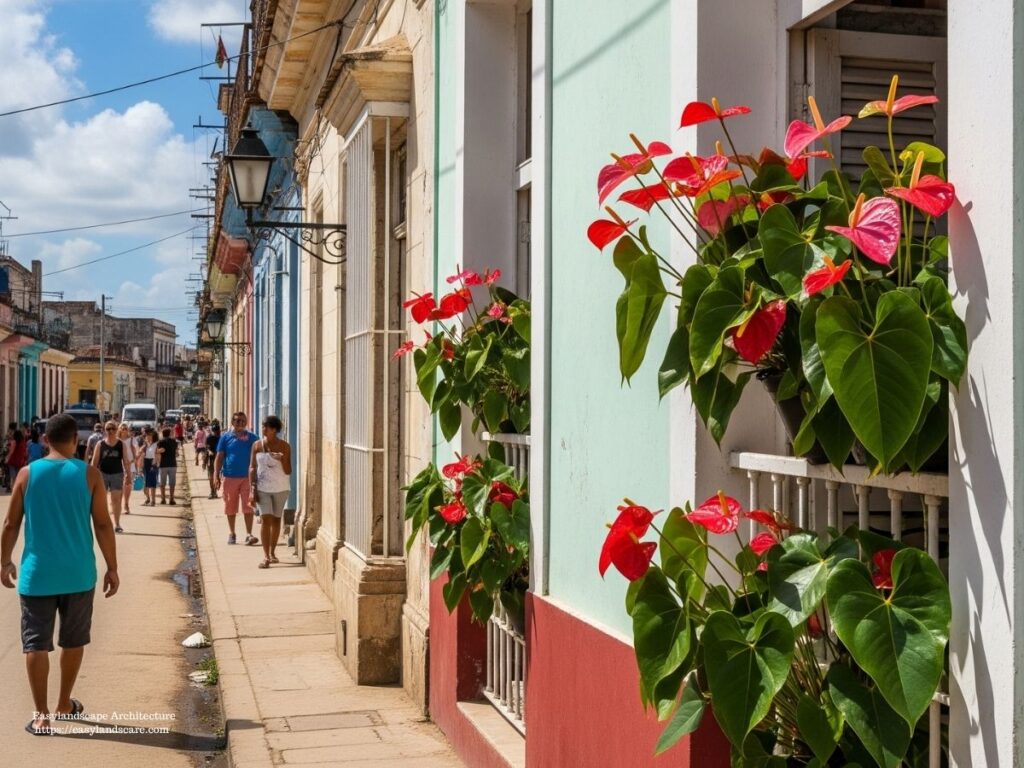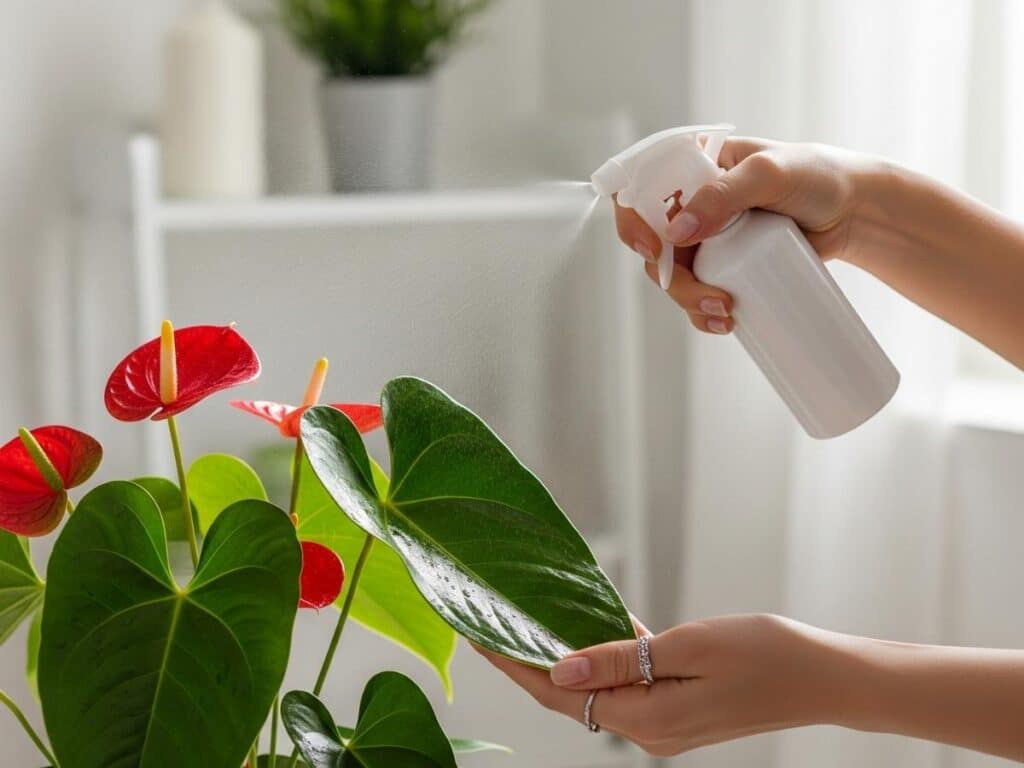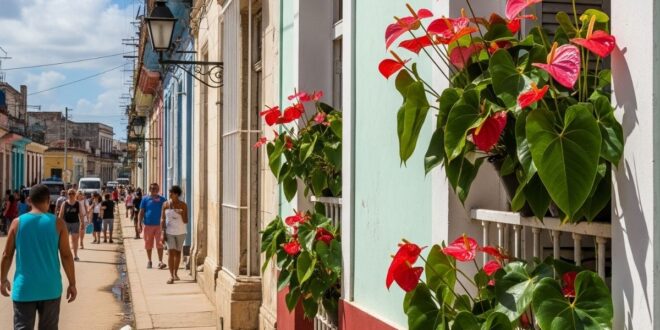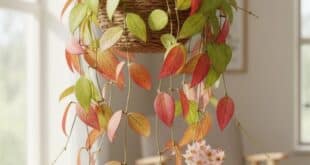Meet The Anthurium
Ever wished you had a plant that looked like a living piece of art, with glossy green leaves and bright, heart-shaped “flowers” that just don’t quit? Well, say hello to the Anthurium! This absolute stunner, often called the Flamingo Flower or Laceleaf, is a superstar in the houseplant world. It comes all the way from the warm, humid rainforests of Central and South America, and trust me, it brings all that tropical charm right into your home.

People adore Anthuriums not just because they’re gorgeous to look at, but also because they’re surprisingly easy to care for and add an instant pop of vibrant color. Ready to discover the secrets to keeping your Anthurium happy and blooming? Let’s dive in!
What Makes an Anthurium So Unique? Those Bright “Flowers” and Shiny Leaves
When you first lay eyes on an Anthurium, you’ll immediately be drawn to its main showstopper: what most folks think of as the “flower.” But here’s a fun fact – it’s not actually a true flower! It’s a special, colorful leaf called a spathe. This spathe is often a brilliant red, cheerful pink, pure white, or even a cool purple, and it’s got that signature glossy, heart shape that we all love. Right in the middle of this colorful spathe, you’ll see a slender, finger-like stalk called a spadix. This is where the real tiny flowers are, but they’re so small we often don’t notice them!
The best part? These vibrant spathes last for an incredibly long time – sometimes up to eight weeks or even more! Imagine that much lasting color. Even the regular leaves are beautiful; they’re a deep green, often heart-shaped too, and wonderfully shiny, making a perfect backdrop for those bold blooms.
Where Do Anthurium Plants Come From? Straight from the Rainforest!
Anthuriums are true tropical babies, born and raised in the steamy, warm rainforests of Central and South America. In their wild homes, they often grow as epiphytes, which means they snuggle onto trees, or lithophytes, growing on rocks, instead of directly in the ground. They absolutely love the dappled sunlight and high humidity found under the thick forest canopy. Knowing about their rainforest roots is super helpful because it tells us exactly what they’ll love in our homes!
What Are Its Other Names? “Flamingo Flower” and “Laceleaf”
You’ll often hear Anthuriums called the “Flamingo Flower” – it’s a perfect fit for their bright color and graceful, bird-like shape. And “Laceleaf” refers to the cool, intricate veins you can sometimes see on their leaves. The actual scientific name, Anthurium, comes from old Greek words that mean “tail flower,” which is a pretty clever way to describe that central spadix. All these names just show how unique and captivating this plant really is!
What Kinds of Anthurium Plants Are There?
While the classic red Anthurium andraeanum is the most common one you’ll spot, the Anthurium family is actually huge and full of surprises!
Popular Anthurium Types: From Classic Reds to Velvety Greens
Anthurium andraeanum:
This is the star of the show for its big, shiny, heart-shaped spathes. You’ll find them in gorgeous reds, soft pinks, pure whites, elegant greens, and even unique purples or speckled varieties. It’s the ultimate “Flamingo Flower” for bringing that vibrant splash.
Anthurium scherzerianum:
Often called the “Pigtail Anthurium,” this one has a fun, curly or spiral-shaped spadix (the central stalk) and comes with bright red or orange spathes. It’s usually a bit smaller overall.
Foliage Anthuriums (like Anthurium clarinervium or Anthurium crystallinum):
Now, these are real showstoppers for their leaves! Even though they do flower, people grow them mostly for their absolutely stunning, large, velvety, dark green leaves. They have super striking veins that pop in silver or white, making them look like a fancy piece of velvet art.
Spathe (“Flower”) Variations: A Rainbow of Colors
The best part about the Anthurium andraeanum type of Anthurium is the amazing range of spathe colors. You can find them in classic reds, soft pinks, pure whites, elegant greens, and even exotic burgundies, purples, or cool patterned varieties. This makes it easy to pick one that perfectly matches your home’s style!
Leaf Looks: Shapes, Textures, and Cool Patterns
Beyond those vibrant spathes, Anthurium leaves themselves come in all sorts of shapes (from wide hearts to long, slender forms), textures (super shiny, matte, or even fuzzy!), and patterns (solid green or those striking veins we just talked about). This means your Anthurium is a gorgeous addition even when it’s not in “bloom.”
How Do You Take Care of Your Anthurium Plant?

Anthuriums are surprisingly easy to look after, especially for a plant that looks so exotic! The real fun is getting them to bloom consistently. Here’s what they truly love:
The Right Light: Bright, Indirect Light for Lots of Blooms!
Your Anthurium will be happiest in bright, indirect light. Think about that dappled sunlight under a rainforest canopy – lots of brightness but no harsh, direct sun beating down on its delicate leaves. A spot near an east or west-facing window is usually perfect. If they don’t get enough light, they might grow well, but you’ll notice far fewer of those beautiful “flowers.” Too much direct sun, on the other hand, can actually burn their leaves and spathes.
Watering Smart: Keep Soil Moist, But Never Soggy!
Anthuriums love consistent moisture, but they absolutely hate having wet feet! That means soggy soil is a big no-no. Water your plant well when the top 1-2 inches (2.5-5 cm) of soil feels just slightly dry when you touch it. Always make sure your pot has fantastic drainage holes – standing water is the quickest way to root rot, which is a major problem for them. You can water a little less often during the cooler, slower winter months.
Cozy Temperatures and High Humidity, Please!
Just like their steamy rainforest home, Anthuriums crave warm temperatures, ideally between 65-80°F (18-27°C). They really dislike cold drafts and sudden drops in temperature, so keep them in a snug spot! And humidity? Oh, they absolutely adore it! If the air in your home is dry (especially with winter heating), you might notice brown tips appearing on their leaves or the colorful spathes drying out too fast. To make them feel right at home, try using a humidifier, placing the pot on a pebble tray with water, or giving them a light misting now and then.
Choosing the Right Soil and Pot: Good Drainage is Key!
Anthuriums prefer a chunky, airy, and well-draining potting mix that still retains some moisture. A mix specifically designed for Aroids (like Monsteras) or orchids, with lots of orchid bark, perlite, coco coir, and a bit of regular potting soil, works beautifully. The main thing is that it drains well! Always pick a pot with drainage holes. They don’t mind being a little bit root-bound, so you usually only need to repot them every 1-2 years, or when you see roots clearly circling the pot. Spring is generally the best time for a fresh start.
Feeding Your Anthurium: Regular Meals for Vibrant Blooms
To get those stunning and long-lasting “flowers,” your Anthurium will appreciate regular feeding during its active growing season (that’s spring and summer). Use a balanced liquid fertilizer that’s made for flowering plants, diluted to half strength, every 2-4 weeks. When fall arrives and winter sets in, you can stop feeding entirely.
What Are Common Problems with Anthurium Plants and How to Fix Them?
Even though they’re pretty tough, Anthuriums can sometimes show signs that they’re not totally happy. Here’s what to look out for:
Brown Tips or Edges on Leaves/Spathes: Usually Humidity or Water Woes
This is a super common problem. Those brown, crispy tips or edges on leaves and especially on the colorful spathes often mean the air is too dry (low humidity) or there’s an issue with your tap water (like high chlorine or fluoride). Over-fertilizing can also cause this.
- The Fix: Boost the humidity around your plant (a humidifier or pebble tray works wonders!), try using distilled or filtered water if your tap water seems harsh, and make sure you’re not over-fertilizing.
Yellowing Leaves: Often Too Much Water or Not Enough Light
If your Anthurium’s leaves are turning yellow, it’s very, very often a sign of overwatering. If the soil stays too wet, its roots can’t breathe and start to rot. It could also be from not enough light, nutrient deficiency, or sometimes even cold drafts. Check your watering first!
Not Many Blooms: Probably Not Enough Light or Nutrients
If your Anthurium isn’t giving you those beautiful “flowers,” the most likely reason is not enough light. It might also be that it’s not getting the right balance of nutrients (too much nitrogen, not enough phosphorus, for example).
- The Fix: Move it to a brighter spot with indirect light. Also, make sure you’re using a fertilizer made for flowering plants during its growing season.
Drooping Leaves: Is It Thirsty or Drowning?
Drooping can be a bit confusing as it can signal both too little water (your plant is super thirsty!) or too much water (the roots are drowning!).
- The Fix: Feel the soil carefully. If it’s bone dry, give it a good drink. If it’s soggy, you might need to let it dry out more.
Pesky Pests: Watch Out for Aphids, Mealybugs, and Spider Mites
Like many houseplants, Anthuriums can sometimes attract common pests like aphids, mealybugs, or spider mites.
- The Fix: Regularly check your plant, especially the undersides of leaves. If you see any tiny invaders, treat them quickly with insecticidal soap or neem oil.
Root Rot: The Big Danger of Overwatering
This is a serious problem caused by soil that stays wet for too long.
- The Fix: Always ensure excellent drainage and allow the soil to dry out between waterings. If you suspect root rot, you might need to repot it into fresh, dry soil after trimming any mushy roots.
Is the Anthurium Plant Safe for My Furry Friends?
Yes, it’s important to be aware: Anthurium plants are considered toxic if eaten. They contain little crystals called calcium oxalates, similar to plants like ZZ plants and Monsteras. If your cats, dogs, or other pets chew on them, these crystals can cause a lot of irritation. You might see symptoms like:
- Strong pain and irritation in their mouth, tongue, and lips
- Lots of drooling
- Vomiting
- Trouble swallowing
- Swelling around their mouth or throat
While it’s usually not deadly, it can be very uncomfortable for your pets. So, it’s highly recommended to keep Anthurium plants out of reach of curious pets and small children. If you think your pet has eaten any part of an Anthurium, please call your vet right away.
Anthurium for Your Home Decor: A Pop of Bold, Lasting Color

Anthuriums are amazing for decorating because of their vibrant, long-lasting “blooms” and sleek leaves:
Creating a Tropical Eye-Catcher
Just one Anthurium in a stylish pot can instantly become a stunning center of attention, adding a bright burst of tropical color and exotic elegance to any room.
Perfect for Bright Tabletops and Shelves
Their neat size and upright growth make them ideal for tabletops, desks, and shelves, where their vibrant spathes can really shine up close.
Brightening Up Bathrooms and Kitchens
Given their love for humidity, Anthuriums can be super happy in well-lit bathrooms or kitchens, adding a cheerful, tropical accent to these busy areas.
A Modern Look That Lasts
With their shiny leaves and clean lines, plus those long-lasting, almost perfect-looking “flowers,” Anthuriums have a distinctly modern and chic vibe. They can truly elevate all sorts of home decor styles
The Charm of Anthurium Plants: Bright Beauty That Sticks Around
The Anthurium plant is a true marvel, offering a captivating blend of striking, long-lasting “blooms,” lush foliage, and a relatively easy-care nature. While it does have specific preferences for light and humidity, meeting these needs is incredibly rewarding when you see those vibrant, heart-shaped spathes emerge. Whether you’re drawn to their bold colors, their unique form, or their tropical elegance, cultivating an Anthurium can be a truly delightful experience, bringing a piece of the rainforest’s vibrant beauty right into your home.
Frequently Asked Questions (FAQ) About Anthurium Plants (H2)
Still have some questions about your Anthurium? Here are some common ones that might help you out!
Q1: Why isn’t my Anthurium blooming or making “flowers”?
A1: The most common reason your Anthurium isn’t showing off its “flowers” is not enough light. They really need bright, indirect light to encourage blooming. Other factors could include too little fertilizer (especially phosphorus), steady temperatures (sometimes a slight dip at night helps!), or maybe your plant is just too young and needs to mature a bit more.
Q2: How often should I water my Anthurium?
A2: Water your Anthurium when the top 1-2 inches (2.5-5 cm) of soil feel slightly dry to the touch. It loves consistent moisture but hates soggy feet! Always ensure your pot has excellent drainage. You’ll likely water more often in warmer months and less often in winter.
Q3: My Anthurium’s leaves are turning yellow. What’s wrong?
A3: If your Anthurium’s leaves are turning yellow, it’s very often a sign of overwatering. If the soil stays too wet, its roots can’t breathe and might start to rot. It could also be from not enough light, a lack of certain nutrients, or sometimes even cold drafts. Always check your watering first!
Q4: Do Anthuriums really need high humidity?
A4: Yes, absolutely! Coming from rainforests, Anthuriums thrive in high humidity. If the air in your home is too dry (especially when you have heating on in winter), you might notice brown tips or edges on their leaves and “flowers.” Using a humidifier, placing the pot on a pebble tray, or grouping plants together can help.
Q5: What kind of soil is best for an Anthurium?
A5: Anthuriums love a chunky, airy, and well-draining potting mix. Think of a mix made for orchids or similar plants. A blend that includes things like orchid bark, perlite, coco coir, and a bit of peat moss, works wonderfully. The key is that it lets water drain easily!
Q6: How long do Anthurium “flowers” (spathes) last?
A6: One of the best things about Anthuriums is how long their colorful spathes last! They can typically stay vibrant for anywhere from 4 to 8 weeks, and sometimes even longer. That means you get continuous color for ages!
Q7: Is it normal for new leaves to be a different color?
A7: Yes, totally normal! New Anthurium leaves often start out a lighter green, or sometimes even reddish or brownish, before gradually hardening off and darkening to the mature deep green. This is completely normal and part of their growing journey.
Q8: How do I get my Anthurium to produce more flowers?
A8: Focus on optimal conditions: consistent bright, indirect light; proper watering (don’t overwater!); high humidity; and regular feeding with a fertilizer designed for flowering plants during the growing season. Also, ensure your plant is mature enough.
Q9: Why are my Anthurium’s flower buds turning brown and not opening?
A9: This is often a sign of stress. It can be caused by very low humidity, sudden changes in temperature, too much direct sunlight, or inconsistent watering (either too dry or too wet). Try to provide a more stable and humid environment.





